Florida State Football: Plan in Place to Improve Doak Campbell Stadium
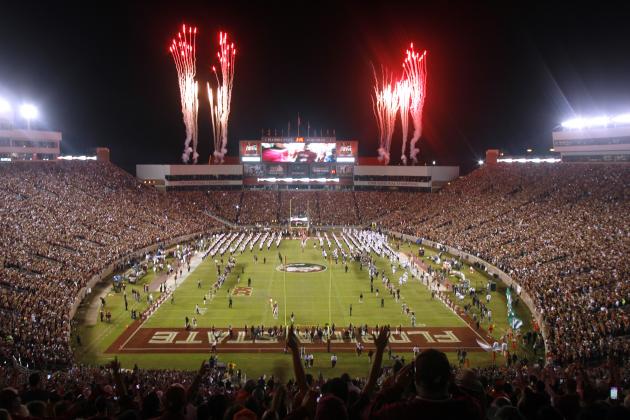
"Just five months after winning a national championship, you can’t blame Florida State for wanting more. And not just another title.
Coach Jimbo Fisher has rebuilt the program from a struggling, fading dynasty into a national champion. And now, FSU administrators and the Seminole Boosters are working to fund a plan that will improve the look of FSU football, including dorms, locker rooms, coaches' offices and Doak Campbell Stadium.In the next few years, pending approval from the Board of Trustees and the Board of Governors this month, plans are in place to build a premium club seat section in the south end zone of Doak Campbell that will help to fund some of football’s facility needs.
Picture an indoor/outdoor experience, where fans can hear the roar of the crowd from cushioned chair back seats and enjoy the comfort of air-conditioned spaces with views of the field. Think “great rooms” where friends can gather, talk and watch football games from around the nation, while eating and drinking and keeping an eye on the field below.
Doak Campbell Stadium looks impressive from the outside, a picturesque building that was decades ago called an "erector set" before it received a stylish brick facade in the early 1990s. Judge a stadium by its cover, and it’s certainly attractive. Inside, a football team that is 45-10 under Fisher is a compelling reason in itself to show up seven Saturdays each fall.
But flip open the first page, and the introduction is less than appealing. The concourses under Doak Campbell are mostly gray. There is rust, there are old bathrooms, there is no way to escape the extreme heat with a cool zone.
College football fans have choices on Saturdays. One of them is simply staying home and watching games on HDTVs, saving hundreds of dollars in gas, food and hotels.
So, school officials and boosters decided to put a plan into action. And buoyed by the success of the product on the field, Doak Campbell will get some needed improvements that will modernize the stadium and also improve the fans’ experience.
The campus, especially the areas close to Doak Campbell, have already changed in the last year. FSU completed the construction of Fisher’s longtime No. 1 wish, an indoor practice facility, in August 2013. The IPF was used frequently to keep the team’s practices on schedule when thunderstorms hit the area. And the boosters opened College Town, a mixed-use development that generates additional money for FSU athletics. Finally, the boosters broke ground on an apartment complex to house the football team. The complex, now named Champions Hall, will also house other FSU students (in compliance with NCAA rules).
The next phase was to address the football team’s facilities, specifically the locker room, players' lounge and coaches' offices, and that work began in late April after FSU's spring football game. FSU isn't adding square footage to these areas as part of the remodeling. But at $5 million to $6 million, FSU should get plenty of bang for its buck.
"With a championship comes many expectations," FSU senior associate athletics director Monk Bonasorte said. "When you're trying to recruit the best athletes in the country and our recruiting has gotten to where it is now, you've just got to stay at that level and maintain that level in all areas of your department. The locker room and the players' lounge, players' meeting rooms, coaches' offices, it's just the total picture of the program as being an elite program."
One of the most striking locker room displays will be statues that pay tribute to FSU players that have retired numbers. Jerseys for players like Chris Weinke, Charlie Ward and Deion Sanders will be displayed and permanently lit. The goal is to display the jerseys like works of art but also motivate current players to strive for individual and team success.
Names and numbers of those who wore that specific number will be on current players' lockers to remind them about FSU's football history.
"The number will always be lit," Bonasorte said. "And that's the belief behind the fact that you're sharing a locker with all the great players who have played here at Florida State."
Minor repairs to Doak will take place this summer but the heavy lifting—sandblasting, removing rust, welding, replacing steel plates, priming and painting—will be put off until money to fund those projects has been secured. Boosters plan to launch the "Champions Campaign" this summer, which will address all of FSU football's facility needs, according to Jerry Kutz, Sr. Vice President of Seminole Boosters, Inc.
"The first stage of the Champions Campaign will address all areas within our football program that coach Fisher and athletic director Stan Wilcox have identified—areas where our players live, work and play," Kutz said. "The second stage of the Champions Campaign will come this fall after the athletic department's comprehensive needs assessment for all sports is complete. Wilcox will prioritize that needs list and the boosters will add those priorities to our Champions Campaign fundraising efforts."A key component of the Champions Campaign's fundraising efforts will be the Champions Club premium seat section, as the project will require a capital gift to qualify for a seat purchase. Those gifts, as well as the revenue generated by the club seats themselves, will fund many of the improvements needed in other areas of the stadium and within football facilities.
"We're looking to build the Champions Club in the south end zone of Doak because there are natural synergies to be realized with the existing University Center Club amenities, the large rooftop decks, and massive spaces under those decks which lend themselves to a 30,000 square-foot air-conditioned club with views of the field and of campus," Kutz said. "Our architects plan to turn an undervalued piece of the stadium into beachfront property."
Club seat holders on both levels will have access to eight diverse indoor and outdoor experiences. In addition to outdoor club seats and the rooftop cabanas, they can enjoy gathering in the 30,000 square foot air-conditioned club on the fourth floor, which features a long glass wall with a view of the game, plus another 25,000 square feet of air-conditioned space on other floors.
"We've surveyed our Seminole Booster members, ticket holders and former ticket holders, asking them what improvements they'd like to see us make to Doak. Those are the guidelines they gave us and we passed on to the architects who drew the conceptual drawings," Kutz said. ''Our members want chair back seats with leg room, where they can be a part of crowd, hear the Warchant and see the pageantry of Osceola and Renegade but be able to escape from time to time to enjoy air conditioning, adult beverages, elevators and upgraded bathrooms. The architects returned a plan to us that incorporates all of those things plus movement between experiences without losing visual contact with the field."
Kutz envisions fans enjoying the club for more than just game days, seeing the possibility for them to enjoy the club area Friday-Sunday on game weekends.
"Champions Club seat holders can entertain guests on Friday for any number of events, perhaps a meet-and-greet happy hour with former players or a party with live entertainment," Kutz said. "Our club seat holders will also be able to entertain guests on Saturday before and/or after the game or for Sunday brunch. That’s a huge feature that’s unique in college athletics."
Granted, the improvements affect less than 10 percent of the seats in Doak Campbell Stadium, reducing capacity to about 80,000. But school and booster officials believe that the Champions Club, if successful, will become an important revenue driver to improve all the seats within the stadium.
While the seat on the couch is always a comfortable option, the improvements will make for a better game day experience; one that could make the trips to Tallahassee more worthwhile—and enjoyable—for years to come."
Competing with SEC's financial muscle as big a challenge as winning on the field
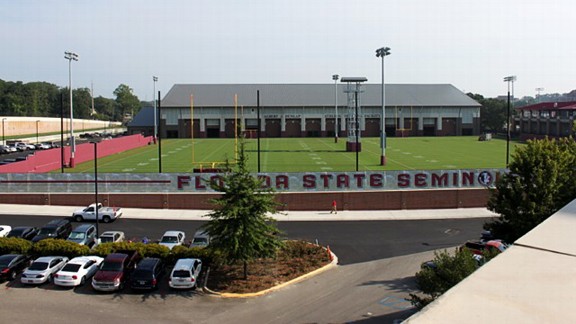 Brandon Mellor/Seminoles.comFlorida State opened its fall camp this week in its new $15 million dollar practice facility.
Brandon Mellor/Seminoles.comFlorida State opened its fall camp this week in its new $15 million dollar practice facility.TALLAHASSEE, Fla. -- The sun baked the practice fields as Florida State opened its fall camp this week, but the first stretches and drills endured by players came in the relative comfort of the school's new $15 million indoor practice facility.
There are few bells and whistles, really. It's a football field housed within a giant warehouse, a practical escape from the oppressive August heat and regular afternoon thunderstorms, an investment in maintaining routine. But more than that, head coach Jimbo Fisher said, it's a symbol of the school's commitment to athletics, dollars spent to show future recruits that Florida State is a place where money is no object and winning has no price tag.
[+] Enlarge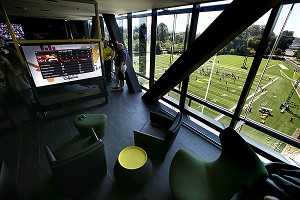

AP Photo/Brian DaviesWhile the likes of Oregon keep upping the ante in the college football arms race, even programs such Florida State are finding it difficult to keep pace.
On the other side of the country, just as Florida State's players dug their cleats into the artificial turf for the first time, Oregon celebrated the opening of a new football operations building of its own. The complex cost $68 million, funded largely by Nike founder Phil Knight, and it features everything from a nearly 300-foot wall of televisions to a weight room furnished with Brazilian hardwood floors. The opulence of the building gained national headlines, but it's simply the latest in an escalating bid by top-tier football programs with deep-pocketed boosters to gain an edge on the field by outspending the competition off of it.
"It's an arms race," said Stan Wilcox, who was introduced as Florida State's new athletic director Wednesday. "That's the reality of college athletics … and we can't allow other universities to continue to have an upper hand on us."
That's the mandate as Wilcox begins his term as the leader of the school's athletic department, and it's a massive undertaking. The financial landscape has changed dramatically even since Florida State last hired an AD in 2008, and while Oregon's gleaming new facilities may not thwart Fisher's recruiting pitch, immense challenges from SEC schools in the region mean the budgetary arms race will only intensify.

It's an arms race. That's the reality of college athletics … and we can't allow other universities to continue to have an upper hand on us. 
--Florida State athletic director Stan WilcoxAmong ACC teams, Florida State is the frontrunner in the race for dollars -- at least among public universities subject to open records laws -- outpacing North Carolina by $18 million in revenue in 2012, according to financial documents. But even as it resides near the top of the food chain among big-budget public universities, Florida State still faces immense pressure to keep pace in an evolving -- and increasingly costly -- financial landscape that threatens to overwhelm smaller programs.
According to documents obtained through open records requests, the FSU athletic department, boosters and development fund generated more than $100 million in revenue last year and put nearly $90 million toward expenses. The athletics department alone shelled out nearly $60 million in operating costs, with more than 20 percent of that going toward football. Those numbers are projected to increase in 2013.
But when it comes to attracting top recruits, hiring coaches and support staff, bringing fans to the stadium and attracting TV viewers, top SEC schools still have a financial advantage -- and it's not simply about conference payouts.
Both Alabama and Florida spent more than $110 million on athletics in 2012, according to documents provided by the schools, while their take from SEC and NCAA distributions amounted to only about $6 million more than Florida State's payout as an ACC member (about $17 million).
Meanwhile, Florida earned nearly $18 million last year in royalties and sponsorships. Georgia takes in more than $10 million annually in multimedia rights deals. Alabama's football program generated more than $30 million in ticket sales alone on its way to a second straight national title in 2012. Top programs aren't simply relying on TV and conference dollars but are finding new streams of revenue that are then invested back into the program.
[+] Enlarge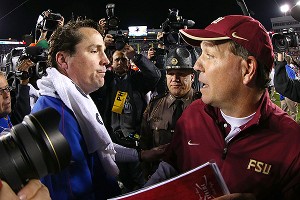

Mike Ehrmann/Getty ImagesJimbo Fisher knows part of the challenge of competing with SEC teams, such as in-state rival Florida, on the field is trying to match the league's financial muscle off it.
"You have to be vigilant about looking at not only your current streams of revenue, but your future streams of revenue," Wilcox said.
There's no direct correlation between spending and wins -- Tennessee and Auburn, a combined 8-16 last season, both outspent FSU, too -- but when those additional resources are allocated wisely, there are distinct advantages.
"The investment [SEC teams] make in what they do, it's paid off. The proof's in the pudding," Fisher said. "Not just in coaches salaries, but all phases of your program. It's critical. And fundraising and booster contributions is the key to all of that."
Fundraising might be paramount, but it's a symbiotic relationship between donors and the teams they fund. Top-notch facilities and winning programs generate demand, but ticket sales are the starting point for revenue streams needed to fund stadium upgrades and athletic budgets.
At Florida State, finding money for major capital projects is an immediate concern. The basketball arena needs massive upgrades, and a recent budget proposal pegged costs as high as $100 million. Plans to refurbish areas of Doak Campbell Stadium with more fan-friendly amenities have been widely discussed as well, with FSU joining a host of other programs in a battle to pry fans away from their televisions and into their arenas.
"With the modernization of everything digital, trying to get the fans into the stadium when they can have at home, a refrigerator, big-screen TVs, big, wide chairs," Wilcox said. "We have to get those individuals off those comfy chairs and into our stadium, so we have to create a fan experience that's second to none within our stadium."
That's a potentially tall order at Florida State.
The program has among the most displaced fan bases in the nation, making travel an expensive proposition for fans. Meanwhile, facilities are in need of upgrades in order to offset the allure of those comfortable living room viewing environments. Add in several seasons of lackluster schedules, and it becomes difficult for Florida State to create the demand for tickets that drives fundraising at SEC schools like Alabama, Florida and Georgia -- all of which noticeably outpaced FSU in football ticket revenue last season.
[+] Enlarge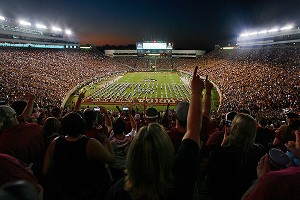

AP Photo/Phil SearsCollege football programs across the country are faced with the challenge of providing a better game-day experience for fans.
"When you have a full stadium, you have a demand for seats, and it has a very positive influence on contributions," said Jerry Kutz, director of communications for Seminole Boosters. "Programs where they can be thought leaders in how to fill a stadium and how to schedule to where it's an attractive schedule for the customer, that's really important."
Florida State is taking steps to boost both ticket sales and donations. Former coach Bobby Bowden has inked a deal to work with the boosters as a fundraiser, and he'll attend games at Doak Campbell Stadium this fall for the first time since his ouster following the 2009 season. Meanwhile, the schedule should provide a boost to season ticket sales in 2014, with a neutral-site game against Oklahoma State and home dates against Notre Dame, Clemson and Florida driving demand.
Increased revenue is essential to offset the rising costs of doing business. Football expenses have grown sharply in the past decade, with scholarship costs rising annually and recruiting expenses and coaching salaries increasing at an unprecedented rate. It's a changing landscape, and maintaining financial flexibility is a priority.
"This requires a different thinking for everyone," FSU president Eric Barron said. "It's managing a race well."
That race doesn't always go to the richest, but those added resources do provide distinct advantages.
This offseason, Fisher hired Jeremy Pruitt as his new defensive coordinator at a cost of $542,000 per year. Pruitt's last job was at Alabama, where just three years ago he worked as an off-field member of the team's operations staff before being promoted to defensive backs coach. His quick rise to prominence is part of a pipeline Alabama coach Nick Saban has developed within his program, not only employing top assistants, but a vast network of support staff to oversee every detail of daily operations.
Saban's model is one Fisher has worked to implement at Florida State, but the scale is hardly the same. In 2012, FSU spent $8.3 million on salaries for Fisher, his assistants, and a support staff of about a dozen quality control and operations people. Alabama, meanwhile, spent more than $13 million and employs a support staff nearly three times that size, including former Clemson defensive coordinator Kevin Steele as a player personnel director at a salary similar to many on-field coaches at other schools. Those support personnel contribute directly to recruiting, film study and player development.
"It's huge. It's about the person you can hire when that money's very good," Fisher said. "You can hire guys, develop your coaches, have guys who can watch film, evaluate film, guys you can trust that you know that's time you can spend more coaching or doing other things. You know things are getting taken care of."
Beyond having the staff in place to identify, target and pitch top recruits, there's a need to invest in the luxury amenities that set a program apart, too.

When you're asking guys to come from a distance and bypass a lot of places, there has to be a reason to go there besides just winning. That's a big thing, but other things do affect it. 
--Florida State head coach Jimbo FisherThe indoor practice facility is a major step in that direction at Florida State, Fisher said, and he predicts a new off-campus housing facility currently underway could sway five or six recruits a year. But FSU is hardly alone in its rampant growth, and with each new palace erected at programs like Oregon or Arkansas, the ever-growing game of one-upmanship takes another step forward.
It's a matter of keeping up with the Joneses, and while all that extra spending might be largely superficial, Fisher said, it's a game top schools can't risk sitting out.
"Guys do notice a difference," Fisher said. "It's not the end all, and it shouldn't be, but it's like when you go to buy a house -- and for them, the cost is the same. You're going to look at other amenities and little things you may fall in love with. … When you're asking guys to come from a distance and bypass a lot of places, there has to be a reason to go there besides just winning. That's a big thing, but other things do affect it."
Through his first three seasons as head coach, Fisher has received enough resources from Florida State to recruit those players to Tallahassee and win with them on the field, but the battle for any extra edge rages on.
When Barron effectively demoted former AD Randy Spetman two months ago, it was with an eye toward a future in which Florida State ranks alongside the elite programs in the country, both on the field and with its checkbook. Wilcox's hire this week was the first step toward ensuring a battle plan is in place for the financial arms race that awaits.
"We want to be in the race," Wilcox said. "We want to be No. 1, not only in the ACC, but in the country."
No comments:
Post a Comment